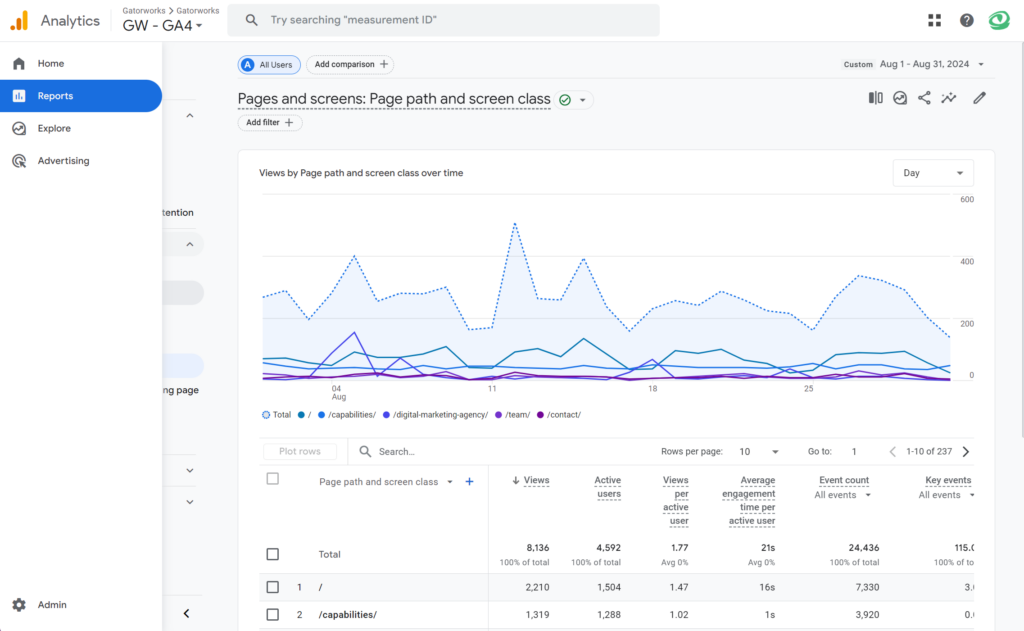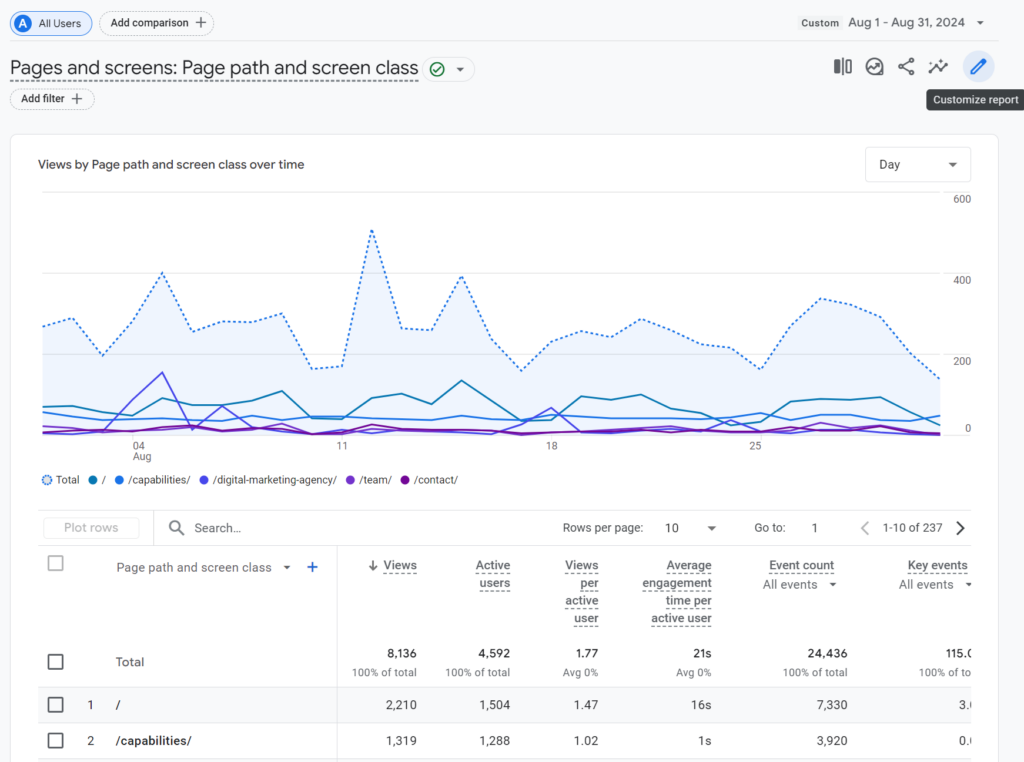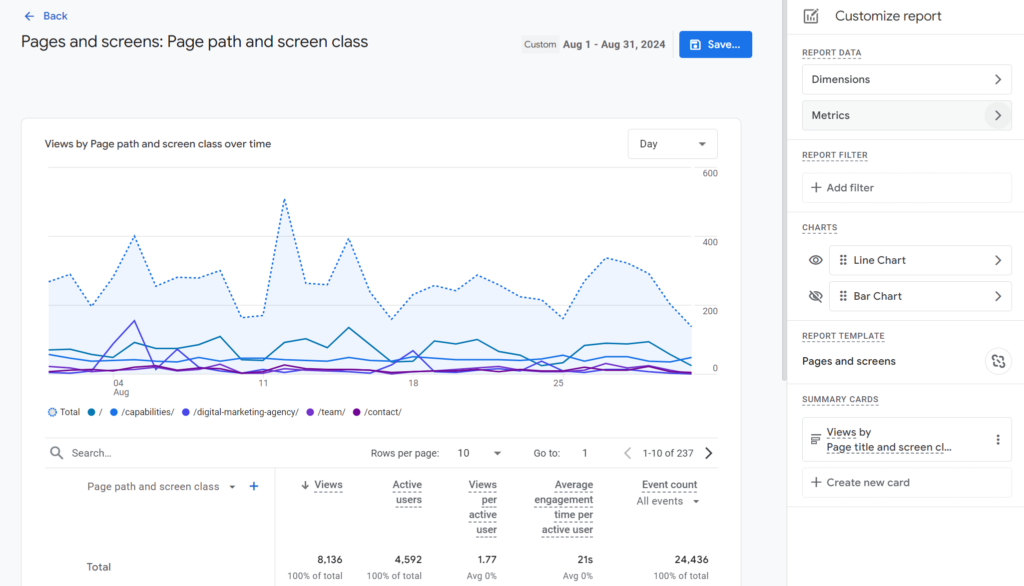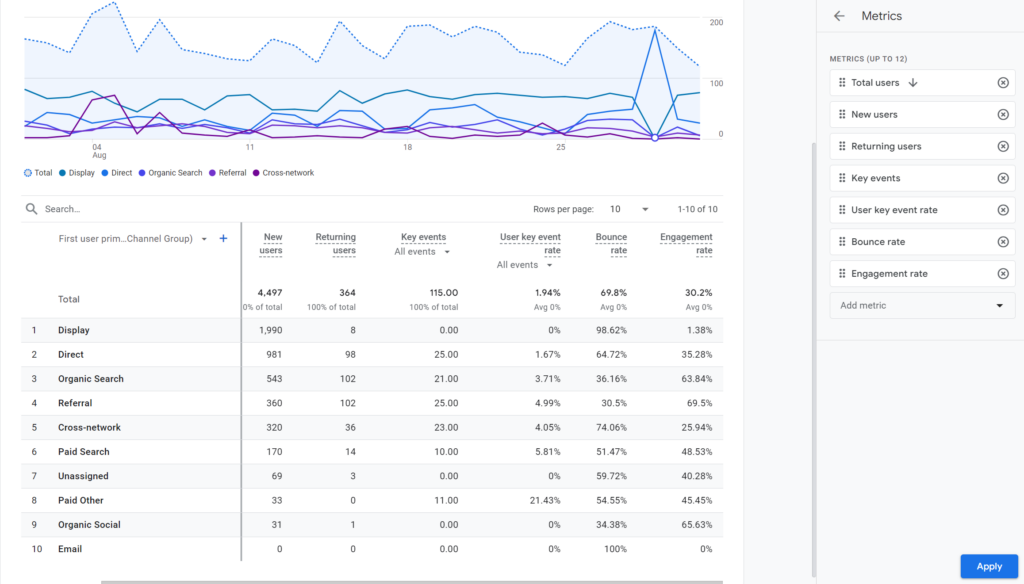
Ever since the Google Analytics 4 (GA4) update, people have been wondering what happened to Bounce Rate. It was a key statistic in Universal Analytics, the previous version of the Google tool, but is nowhere to be found in GA4. If you’re like our clients, you’re wondering why this is and what you can do to adjust?
Rest assured, Bounce Rate isn’t gone. It just isn’t as prominent or as easily used as it used to be.
So, why did it become less prominent? Well, this boils down to the difference between bounce rate and engagement rate. Google users had complained for years that Bounce Rate wasn’t really reflective of the metric they wanted. They didn’t want to know how many people left the website; they wanted to know how many people stayed and interacted. This new engagement rate statistic is more reflective of that aim.
Understanding the differences between bounce rate vs. engagement rate in GA4 can give you insights into areas of improvement, allowing you to enhance the user experience of your target audience and drive higher conversion rates.
At Gatorworks, we recognize that optimizing these metrics is essential for driving traffic and fostering visitor loyalty. Let’s explore how effectively analyzing bounce rate and engagement rate allows you to tailor your marketing strategy to create engaging content that attracts visitors and encourages them to explore further.
What Is Bounce Rate and Engagement Rate?
Bounce rate measures the percentage of visitors who leave your website after viewing only one page. It helps you understand if users find your content engaging enough to explore further.
On the other hand, engagement rate in GA4 measures the percentage of engaged sessions from users. So, it is essentially the reverse of the previous statistic.
But what are engaged sessions?
These occur when users interact with your website for over 10 seconds, trigger a conversion event, or view multiple pages. These sessions indicate deeper user interaction with your website, providing better insights into user behavior.
How Are Bounce Rate and Engagement Rate Different?
Interestingly, these two metrics are inversely related — a high bounce rate often indicates a low engagement rate. Additionally, engagement rate considers how much time users spend on pages and their interactions, offering a more comprehensive view of user behavior.
You may also wonder — are website and social media engagement rates different?
Website engagement rates directly measure user activity on your site, reflecting how visitors interact with your content, navigate pages, and engage with various elements. In contrast, social media engagement rates assess interactions such as likes, shares, comments, and overall post reach on platforms like Facebook, Instagram, and Twitter.
Website metrics focus on content depth and user journey, while social media metrics emphasize external engagement and brand visibility.
What Is a Good Bounce Rate and Engagement Rate?
A good bounce rate varies by industry, but generally, an average bounce rate ranges from 27% to 48% depending on your industry. Anything above 60% may indicate issues with content or user experience.
Like bounce rates, a good engagement rate depends on your goals and industry. Engagement rates ranging from 60-75% are considered strong, indicating that users find your content valuable and engaging.
Can You Still Track Bounce Rate in GA4?
In Google Analytics 4, bounce rate metrics are not as easily tracked as in previous versions. Instead, GA4 introduces engagement rate as a more meaningful metric.
The engagement rate measures user interactions beyond just viewing a single page. While GA4 still calculates bounce rate, it does so as the percentage of sessions that are not engaged.
This shift encourages marketers to focus on deeper user interactions rather than solely on the traditional bounce rate statistic.
How Do You Find Your Bounce and Engagement Rate in Google Analytics?
Bounce rate and engagement rate can be found in your reports within GA4. If your reports are not customized to show these metrics, follow these simple steps:
1. Start by opening the report you want to edit.
Navigate to the specific report you want to modify within your Google Analytics 4 dashboard. This can be found under the “Reports” section in the left-hand menu.
2. Click Customize (the pencil icon) in the top right corner.
Once you’re in the report, look for the pencil icon located at the top right corner of the screen. Clicking this will open the customization options for that report.
3. Click Metrics, and add Engagement Rate and Bounce Rate.
In the customization menu, select “Metrics” to view all available metrics. Search for “Engagement Rate” and “Bounce Rate,” then click to add them to your report.
4. Click Apply to save your edits.
After selecting your metrics, click the “Apply” button to save your changes. The report will refresh, displaying both the Engagement Rate and Bounce Rate metrics.
How to Calculate Bounce Rate and Engagement Rate
In GA4, the bounce rate is defined as 100% minus the engagement rate. To calculate the bounce rate, divide the number of single-page sessions by the total number of sessions. Similarly, the engagement rate is calculated by dividing the number of engaged sessions by the total number of sessions.
When calculating bounce rate vs. engagement rate in GA4, use this formula:
- Bounce rate = (Single-page sessions/Total sessions) x 100
- Engagement rate = (Engaged sessions/Total sessions) x 100
How Do Good and Bad Bounce Rates Affect Websites?
A strong engagement with a low bounce rate indicates significant user interest and effective content. This combination can boost user satisfaction, drive higher conversions, and enhance SEO performance.
This also indicates that the content is relevant and valuable.
Now, let’s look at the opposite scenario —
A high bounce rate with a low engagement rate signals potential issues with content relevance or user experience, like slow page speed. These challenges can adversely impact conversions, making it essential to address them quickly and effectively.
Does Bounce Rate Influence Google Rankings?
The short answer: No, not directly. However, it is an important indicator of user experience and content quality.
A high bounce rate may suggest that users are not finding what they expect on your page. If users frequently and quickly leave your site, it could signal to Google that your content is less valuable.
This indirect effect can influence your overall ranking over time.
To prevent a drop in rankings, it is essential to monitor bounce rate vs. engagement rate in GA4 to understand user behavior and make necessary adjustments. This allows you to improve user satisfaction and, as a result, SEO performance.
How to Improve Bounce Rate vs. Engagement Rate in GA4
How to Lower Bounce Rate:
- Enhance page load speed by optimizing images, using browser caching, and more.
- Optimize your website for use on mobile devices.
- Ensure content matches user intent.
- Use compelling calls-to-action.
- Minimize the steps users have to take to get to the content they want.
How to Increase Engagement Rate:
- Encourage user feedback and participation.
- Use internal linking to guide visitors seamlessly through your content.
- Add interactive elements like videos and quizzes.
- Provide clear and concise information. Keep them reading!
Elevate Your Website With Gatorworks
Understanding bounce rates and engagement is crucial for your website’s success. At Gatorworks, we provide customized solutions to optimize user experience and ensure your content connects with your audience.
Whether you need web design or development, content marketing, or Search Engine Optimization, our team can help you build or optimize your site for maximum engagement.
Start by reaching out online or calling us at 225-924-6109. Connect with Gatorworks today and transform your website into a dynamic platform that drives real results.




